Visit your favourite destinations |
| A Report from birdtours.co.uk |
Chilean Patagonia and Tierra del Fuego, 21st Dec 2012 - 6th Jan 2013 ,
Las Solanas 33, Villanueva de la Vera, Cáceres 10470, Extremadura, Spain
Star Birds
King Penguin, Torrent Duck, Magellanic Plover, Southern Royal Albatross, Tawny-Throated Dotterel, Rufous-Chested Dotterel
Logistics
We flew by a combination of LAN/TAM (the two airlines have merged) on a three-legged route from Madrid to Sao Paolo, and then on to Santiago and lastly to Punta Arenas. On the way back our first flight from Punta Arenas was cancelled, as far as we could see simply because it wasn’t full and therefore wasn’t profitable for the company. No other cogent reason was given. This was basically our experience with LAN/TAM. Once you’re on the flights they’re fine, but arm yourself with patience and be prepared for long airport waits (11 hours in Sao Paolo crammed into a corridor, 7 hours in Punta Arenas, etc). After the cancellation of our outward flight from Punta Arenas it in fact turned out OK for us because our rearranged schedule included a direct flight from Santiago back to Madrid without passing through the dreaded Sao Paolo.
From Punta Arenas we took the Austral Boom ferry directly to Porvenir. This 2½-hour ferry crossing (best to book beforehand) is excellent for marine birds, turning up a stunning Southern Royal Albatross (largest wingspan on the planet), Black-Browed Albatross, Giant Petrel, Magellanic Diving Petrel, etc. We came back on the shorter ferry (run by the same company) across the narrow part of the strait further east called Angostura, from Bahía Azul to Punta Delgada. This ferry is much cheaper, logically, and can’t be booked beforehand. You just wait in line for the two ferries to shuttle you across. It does involve a drive of 200+ k along dodgy roads (see below) to get back to Punta Arenas, but the drive is good for goodies like Chocolate-Vented Tyrant and once across the other side you can drive up the entrance road to Pali Aike and look for the two dotterels. The crossing itself is good for the stunning Commerson’s Dolphin.
Roads
Most of the roads in Chilean Patagonia and Tierra del Fuego, even some stretches of the main roads, are “ripio”, i.e., dirt tracks of varying states of maintenance. They’re pretty hard going and tough on tyres and suspension, not to mention backs and necks. We hired a Volkswagen Bora from Europecar and just about made it, destroying one tyre on the way. With the benefit of hindsight we would definitely have splashed out the extra on a 4-wheel drive.
Eating and Sleeping
Hotels were pretty much of a muchness in terms of prices and facilities, with only basic breakfasts. One to avoid, in our experience, is Hostal El Mirador in Punta Arenas where breakfasts touched an all-time low. On one occasion the muesli had blue mould and the bread rolls already had bites taken out of them. Woeful. The best hotel by a long long way was Hostería Yendegaia in Porvenir, with excellent knowledge about local birds (see later) and a fine sense of the needs of birders, for example offering breakfast (pretty good) at any time from 5 to 10.30 to suit that day’s field trip. There was also a continual flask of hot water on the go to make tea or coffee when you come back from a wind-buffeted field trip, an essential touch that no other hotel offered.
Punta Arenas has some really nice cafés and there is a nifty “Tenedor Libre” (all-you-can-eat buffet) on the high street for a set price of 7000 pesos a head (about 10 quid or 11 euros). The café called Kau Patagonia in Puerto Natales has fantastic views over the strait and the Andes. Watch out for Peale’s Dolphins and Condors while you sip your cappuccino. In Puerto Natales we also really liked the restaurant El Living on the main square, with variable, imaginative food and good music.
Weather and Birdsong
Most days are windy at least in the afternoon and sometimes all day. Temperatures out of the wind are fine and it rained little. Good windcheaters both for body and legs are recommendable. Because of the prevailing wind birdsong is sometimes hard to hear even when they bother performing. Austral Thrushes (sounding a bit like Song Thrushes) often put on a nice show in towns, villages and woods. An indefatigable and almost omnipresent singer even on the windiest days is Rufous-Collared Sparrow. Austral Blackbird we only heard once but it’s a really nice modulated song. The commonest singers in open country are the two common sierra finches, Grey-Hooded and Patagonian, Austral Canastero, Correndera Pipit and Long-Tailed Meadowlark, all interesting in their way. In general don’t expect wall-to-wall birdsong as in a European spring. We heard one frustratingly brief snatch of Patagonian Mockingbird south of Punta Arenas. On the road from Punta Arenas to Puerto Natales we greatly enjoyed a winnowing Magellanic Snipe. It’s much more developed than the simple bleating of Europe’s Snipe. Fascinating to hear.
Field Guide
We used Alvaro Jaramillo’s Birds of Chile. The illustrations in this book are so good for identification purposes that, after genning up for a few months beforehand, we were able to identify most of the birds on sight. The text is good too but some of the distribution maps seem to need updating.
Daily Log
23.12.12. Punta Arenas to Porvenir
Arriving at the airport at five in the morning we had to wait a couple of hours to pick up the car and decided to walk around the airport itself, see what gives. In the carpark itself we had Austral Thrush, Austral Negrito (very common everywhere, delightful bird), Rufous-Collared Sparrow (abundant) Black-Faced Ibis and, most remarkably of all a very tame pair of Least Seedsnipe (photo 1). Amazing start even before picking up the car.
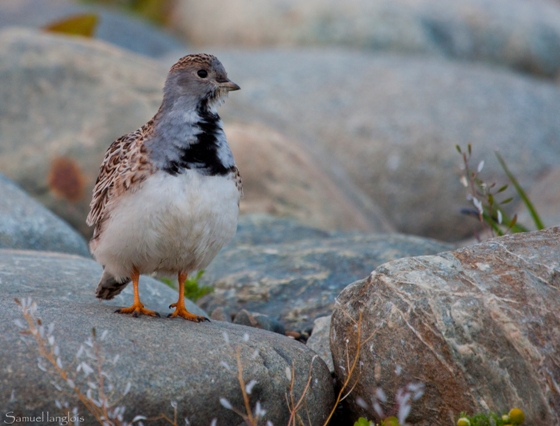
As soon as we got the car, we headed for the wetland called Humedal Tres Puentes on the outskirts of Punta Arenas before catching the ferry. You drive right past it on the way from the airport to the ferry terminal. This turned up 1 American Kestrel, 20+ Southern Lapwing, 5+ Crested Duck with young, 20+ Upland Geese, 10+ Chloe Wigeon, Red-Gartered Coot And White-Winged Coot, Chilean Swallow, 2 Flying Steamer Ducks and the first Magellanic Snipe. All these birds were to prove very common over the coming days.
While waiting for the ferry we saw our first Dolphin Gulls (much commoner than most books say, present on nearly every beach), Imperial Cormorant, Rock Cormorant, more Black-Faced Ibis (very common too) and our first 2 Flightless Steamer Ducks. Kelp Gulls and Brown-Headed Gulls are soon seen anywhere near the sea or bodies of water.
The first part of the crossing to Porvenir was a bit disappointing with only South American Terns (abundant), 10 Magellanic Penguin (our first ever penguins!), about 20 Magellanic Diving Petrel, scurrying low over the sea like our auks and 30+ Chilean Skua (common everywhere and flagrant bullies). In all we saw about 50 Giant Petrel on the crossing. At last we ran into a raft of about 30 Black-Browed Albatross but none flying as yet. Imagine our surprise when the first flying albatross that glided into view turned out to be a magnificent Southern Royal Albatross (photo 2). An astonishing sight. In the second half of the crossing we saw quite a few Black-Broweds too. They seemed small by comparison!
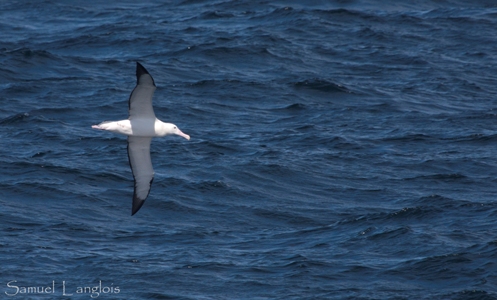
We lucked into a good hotel in Porvenir, the Hosteria Yendegaia, where one of the area’s best ornithologists, Enrique Couve, offered to guide us to the much coveted Magellanic Plover on the nearby Laguna de los Cisnes. Just as well. The lake is vast and we’d never have found the bird unaided. Basically, drive out of Porvenir towards the aerodrome on an asphalted road. Just before the aerodrome itself turn left onto a dirt track and follow this for about 3 k, losing sight of the lake itself on the left. After passing a couple of cattle grids with barking dogs tied to them, you come to another cattle grid where the path forks immediately afterwards, the left hand fork rising a little. Park here (allowing other vehicles to pass on the lower track) and walk down leftwards to the lake. It may or may not be visible from here depending on how much it has rained lately. When you get to the water keep your eyes peeled for the Magellanic Plover among the plentiful Bairds and White-Rumped Sandpipers and Two-Banded Plovers. While we were looking for the bird on this occasion we also saw 3 Lesser Yellowlegs. Two Cinereous Harriers flew by (these proved to be fairly regular sightings on the trip) and we saw our first Black-Necked Swans and Coscoroba Swans, both common, 15 Chilean Flamingo, Speckled Teal (common), 4 more Least Seedsnipe, 20 Red-Tailed Meadowlark, 2 Great Grebe, 1 Correndera Pipit, singing Grey-Hooded Sierra Finches and at last, when we’d almost given up hope, the charismatic bubblegum-legged Magellanic Plover. Undoubtedly one of the birds of the trip (photo 3). Not a bad first day!!
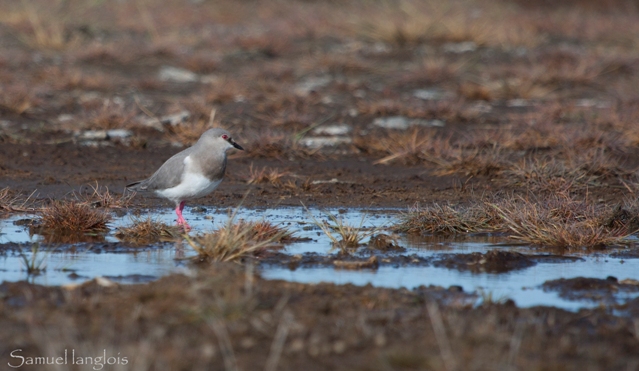
24.12.12. Porvenir to Bahía Inútil
The second day was devoted to the magnificent King Penguin colony in Bahía Inútil. To get there you have to drive about 120 k along the Y71 and Y85, roads, our first taste of “ripio” driving. On the way we saw our first and only Variable Hawk. Probably they’re commoner further north. Apart from the abundant Upland Geese we also saw our first 8 Ashy-Headed goose and 2 distant Ruddy-Headed Geese. New birds seen apart from some repeat cast from yesterday were Southern Caracara (the commonest raptor on Tierra del Fuego, most of them immatures) and 20 Short-Billed Miner. At last we made it to the King Penguin colony and lived along with them blissfully for hours (photo 4). It’s a life-changing experience. There seemed to be about 12 incubating eggs. Fingers crossed for breeding success this year.
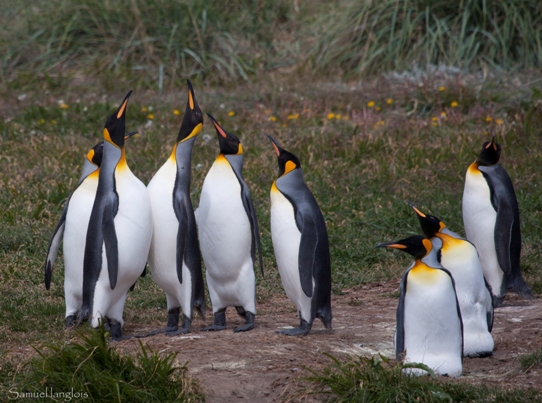
25.12.12. Porvenir and Laguna de los Cisnes
A repeat morning visit to Laguna de los Cisnes turned up more singing Grey-Hooded Sierra Finches, many with young; 2 Southern House Wren (abundant everywhere), 1 Bar-Winged Cinclodes, 1 Dark-Bellied Cinclodes (both very common in suitable habitat near water), and 1 splendid Scale-Throated Earthcreeper, the only one we saw on the trip. We also recorded our first Magellanic Oystercatchers, common on the coast and large bodies of water. A very unfriendly landowner threw us off his property before we could get to grips with the Magellanic Plover again. Back in Porvenir we were told that he had no right to do so, as the Lake is a world heritage site and all surrounding land owners are duty bound to grant access. Maybe so, but he was just too furious to reason with. Maybe if we hadn’t seen the Magellanic Plover already . . .
Around Porvenir in the afternoon we saw Eared Doves, lots of the very common Black-Chinned Siskin, singing and feeding young, immature Black-Crowned Night Herons, 1 Cinnamon-Bellied Tyrant and 1 White-Crested Elaenia (much commoner later in wooded habitat). A particularly curious sight was Dolphin Gulls perched in the top of pine trees!
26.12.12. Porvenir to Pali Aike
This day we decided to drive from Porvenir to Bahía azul, cross the strait on the short ferry to Punta Delgada and investigate the entrance road to Pali Aike for Chocolate-Vented Tyrants and the two dotterels. The first Chocolate-Vented Tyrants turned up while still on Tierra del Fuego with more on the other side. Bahía Azul beach, while waiting for our car to fit on the ferry, turned up more Cinnamon-Bellied Ground Tyrants and Bar-Winged Cinclodes, both entering their nests and, surprisingly, our only Patagonian Yellow Finch of the whole trip.
The Bahia Azul to Punta Delgada crossing provided us with 20 Magellanic Diving Petrel, 1 Giant Petrel and 2 Commerson’s Dolphins.
The entrance road to Pali Aike proved something of a disappointment with heavy lorry traffic. Nonetheless we did see our first Darwin’s Rhea, including two with huge coveys of young (20 and 18), a couple of Black-Throated Finches, 4 more Chocolate-Vented Tyrants, 4 Common Miner, 10 more Least Seedsnipe and, at last, after a long trek over barren puna, 2 perky Tawny-Throated Dotterels. No Rufous-Chested Dotterels, but the area struck us as too dry, though they are said to be there. The return crossing back to Tierra del Fuego and the drive back to Porvenir produced nothing of note.
27.12.12. Porvenir to Bahía Inútil using the alternative Y635 route
This day we returned to the Bahía Inútil King Penguin colony along the Y635 road, no worse than the “main” road. This is very recommendable, because at about K 25 there is a beautiful pair of Rufous-Chested Dotterel, the dotterel we dipped out on yesterday, so we were delighted to get such good views of this beauty on this trip (photo 5). The first Austral Canasteros were very easy to find now that we had learned their trilling song and we also saw our first 2 Blue-and-White Swallows (much less common than the abundant Chilean Swallow).
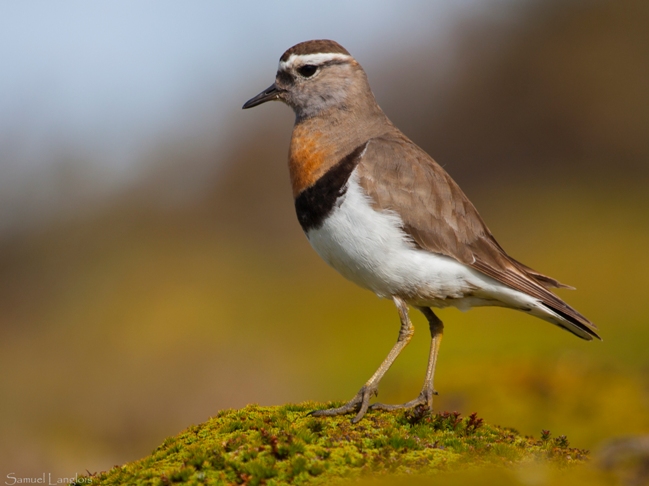
The Bahía Inútil King Penguin colony fully repaid its second visit with Giant Petrel and Black-Browed Albatross flying along the beach and another Commerson’s Dolphin spotted offshore.
28.12.12. Laguna de los Cisnes and Laguna Verde
After another hard car drive the day before, we devoted this day to a leisurely drive and stroll around Laguna de los Cisnes and Laguna Verde on a morning of pleasant sunshine and no wind, seeing 1 Yellow Billed Pintail, 1 Lesser Yellowlegs, 5 Great Grebe (photo 6), 4 Flying Steamer Duck, 8 Chilean Flamingo, 2 Austral Canastero, 1 Bar-Winged Cinclodes.
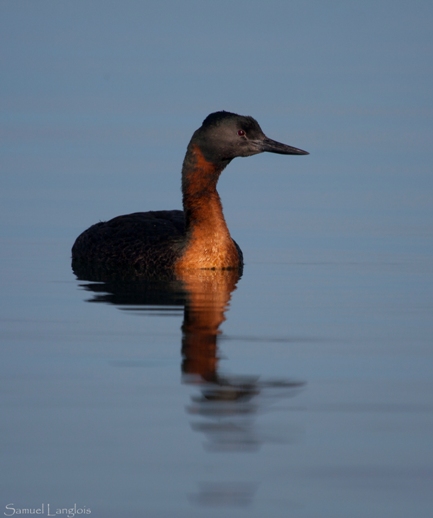
29.12.12. Drive back to the mainland
A real gale was blowing this day so it was a good choice to spend it on the long drive back to Bahía Azul to cross over to Punta Delgada and drive back to Punta Arenas, saying goodbye definitively to Tierra del Fuego. The first Chimango Caracaras, which we were surprised not to see on Tierra del Fuego, turned up close to Punta Arenas and proved very common thereafter. We dropped into Humedal Tres Puentes again to see 2 families of White-Tufted Grebe with young, 1 imm. Silvery Grebe, 20+ Chiloe wigeon, some with young, 2 Yellow-Billed Pintail and 10 Ashy-Headed Geese among the abundant Upland Geese.
30.12.12. Seno Otway
On the ripio drive in to Seno Otway from the Punta Arenas-Puerto Natales road we were delighted to see 6 Fire-Eyed Diucon (photo 7) plus our first 5 Andean Condors.
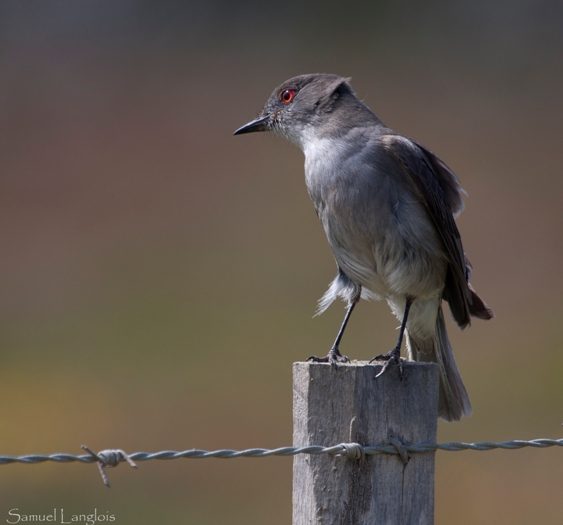
Our only Turkey Vulture of the trip also flew over. The charming Magellanic Penguins were tending their young in the burrows with some older chicks in a crèche on the beach along with 2 Flightless Steamer Ducks and our first Neotropic Cormorant. Dark-Bellied Cinclodes were nesting in the roof of the beach hide, feeding on the beach itself and singing well. Correndera Pipits also singing roundabout. On the drive back we got more lovely views of Fire-Eyed Diucon on the roadside posts and bushes with our first Austral Blackbirds slightly further off.
31.12.12. Punta Arenas towards Fuerte Bulnes and Laguna Parrillar
This day we spent on a drive southwards from Punta Arenas towards Fuerte Bulnes, looking for Kelp Geese along the coast and dropping into Laguna Parrillar to see what woodland birds turned up. Surprisingly, one of the first birds we saw at the lake was another gorgeous Rufous-Chested Dotterel. The lake did not produce the hoped-for Ringed Kingfisher; neither did the surrounding woodland provide any sightings of Magellanic Woodpecker. Birds we did see were our first Thorn-Tailed Rayaditos, 10+ Austral Blackbird, one singing very well, 2 more Dark-Bellied Cinclodes, our first 7 Austral Parakeet, 1 Fire-Eyed Diucon, 15 White-Crested Elaenia, with their surprisingly strong song/call for such a small bird, 12 Black-Chinned Siskin in full song and feeding young, 6 Southern House Wren, some feeding young too.
On the road further south to San Juan we found the hoped-for pair of Kelp Geese plus more Cinereous Harriers and an unexpected pair of Spectacled Duck with two fully grown young. Seven Peale’s Dolphin with a couple of young amongst them were feeding and cavorting just off the beach accompanied by 4 Giant Petrel and 1 Black-Browed Albatross.
Back in Punta Arenas our only Peregrine Falcon (pallid phase) flew over the city that evening, the last bird we saw in 2012.
1.1.13. Punta Arenas towards San Juan
This day we decided to revisit the area south of Punta Arenas towards San Juan, not the best choice because the new year’s day tradition around here is to drive out en masse and roast huge beasts in the countryside, with parked cars and partying people everywhere. Nonetheless we did manage to get 6 more sightings of Peale’s dolphins in all, in pods of from 3 to 9, some so close to the shore you could hear their blow and the noise of them breaking the surface. A nice male Cinereous Harrier flew by and this was also the day we had a frustratingly brief hearing of Patagonian Mockingbird. To escape the crowds we walked into a very attractive wood with mature trees and found Ashy-Headed Geese breeding deep within it, the adults doing the broken-wing trick to distract us from the young. After a long walk along the river, seeing 2 Patagonian Sierra Finches (singing), many more White-Crested Eleanias singing, 2 more Fire-Eyed Diucon and 2 Austral Parakeet, we at last found a splendid and very confiding pair of Ringed Kingfisher (photo 8).
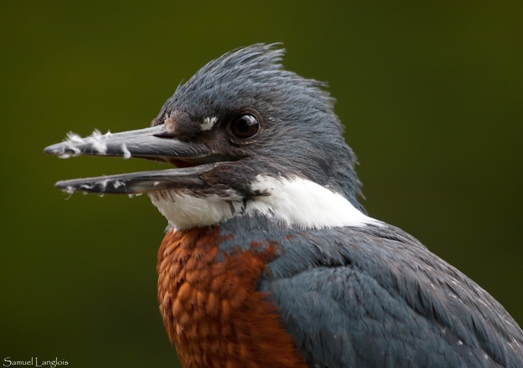
2.1.12. Punta Arenas to Puerto Natales
On the drive this day from Punta Arenas to Puerto Natales we saw 1 imm. Black-Breasted Buzzard Eagle, 6 Greater Yellowlegs, 6 Lesser Yellowlegs, 3 Ashy-Headed Goose, 1 Condor, 2 Andean Ruddy Duck, 2 Fire-Eyed Diucon, 25 Austral Parakeet and heard the winnowing Magellanic Snipe.
In Puerto Natales itself there were 300+ Black-Necked Swan, 1 Male Cinereous Harrier and another pod of dolphins in the harbour, probably Peale’s.
3.1.13. Puerto Natales to Torres del Paine (Lago Grey)
This day’s drive from Puerto Natales to Torres del Paine produced 5 adult Black-Chested Buzzard Eagle, some perched on roadside posts and trees, 6 Condor, 1 beautiful pair of Silvery Grebes, one carrying two young on its back, 1 Black-Winged Ground Dove and 1 Aplomado Falcon.
Around Hostería de Grey we searched in vain for both Magellanic Woodpecker in the woods and Torrent Duck on the river, seeing “only” 1 Fire-Eyed Diucon, 3 Austral Parakeet and 10 Rayaditos. Blue-and-White Swallows were commoner here among the many Chilean Swallows braving the gale over the river. On the drive back to Puerto Natales, more Black-Chested Buzzard Eagles and the trip’s only Short-Eared Owl hunting at dusk.
By the way, keep your Torres del Paine entrance ticket safe because it’s good for 3 days. Entrance prices in general in Chile are expensive and you don’t want to pay twice if you can avoid it.
4.1.13. Puerto Natales to Reserva Natural Bernard O’Higgins
After the really hard driving around Torres del Paine we rested up this day and took a fairly tacky boat trip from Puerto Natales to the Serrano and Balmaceda Glaciers, seeing of note only more Peale’s Dolphin, totalling about 10 individuals, 6 Condor, 11 Ashy-Headed Geese, some with small young, and our only 2 Barn Swallows of the trip. The idea, after missing out on Torrent Duck the day before at Lago Grey, was to rest up today and dedicate our last full day tomorrow to an all-out search for this incredible bird around Laguna Amarga, on the outskirts of Torres del Paine.
5.1.13. Puerto Natales to Laguna Amarga
The drive from Puerto Natales to Laguna Amarga produced 8 more Condors and 5 more Black-Chested Buzzard Eagles. This time, instead of heading for the heart of Torres del Paine, we took the Laguna Amarga loop (the road is no worse) heading for the waterfall called Cascada Paine, where Torrent Duck are said to be regular. We parked up at the waterfall and walked down to it, soon spotting a wonderful female Torrent Duck, diving and feeding up river. In the end we were able to get pretty close (she came towards us) and watched her diving and hauling out on rocks for about half an hour (photo 9).
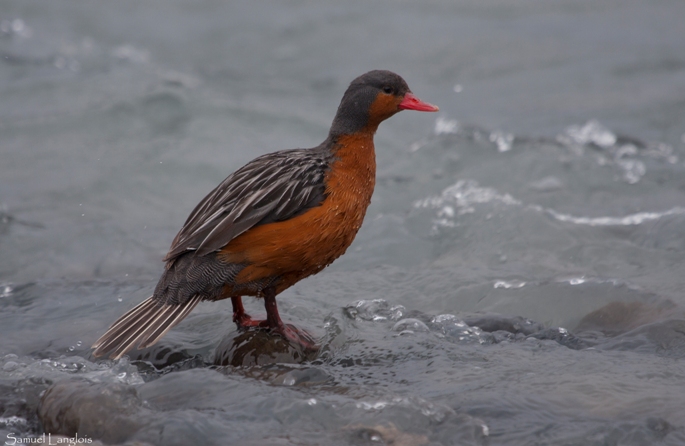
However much you read about this bird’s mastery of the rapids, to watch it perform is truly spellbinding. How it does it is unfathomable. Further off we also saw a fully-grown immature, probably a male, cross the river swimming and an adult male fly across. This area, surprisingly, with so few trees and most of those burnt, produced the trip’s only Chilean Flicker.
So that wrapped up a wonderful two weeks in Southern Chile. The last day was almost solid travel with no notable sightings. Just about the only target birds we missed out on during this trip were Patagonian Woodpecker, Blackish Oystercatcher and White-Throated Caracara. All the rest of the wish-list we saw, sometimes staggeringly well (King Penguin, Torrent Duck, Ringed Kingfisher, Rufous-Chested Dotterel). In general we found birds pretty confiding (especially the geese), probably because there is little hunting. Though the bird list here is not massive (we saw 96 species, only 4 of which we’d seen before: Peregrine, Short-Eared Owl, Barn Swallow and House Sparrow), the quality is high, with gems like King Penguin, Torrent Duck and the two dotterels, plus really class passerines like Chocolate-Vented Tyrant, Fire-Eyed Diucon, etc. With the world’s only easily-accessible (everything is relative) King Penguin colony now apparently established, this is a highly recommended trip. A lot more photos from this trip and descriptions in Spanish can be found at http://avesdelavera.blogspot.com.es
Why not send us a report, or an update to one of your current reports?